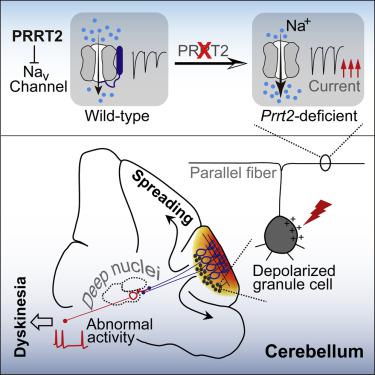Cell Reports ( IF 7.5 ) Pub Date : 2021-09-21 , DOI: 10.1016/j.celrep.2021.109743 Bin Lu 1 , Sen-Sen Lou 2 , Ruo-Shui Xu 2 , De-Lun Kong 3 , Rong-Jie Wu 3 , Jing Zhang 1 , Ling Zhuang 2 , Xue-Mei Wu 3 , Jun-Yan He 2 , Zhi-Ying Wu 4 , Zhi-Qi Xiong 5

|
Paroxysmal kinesigenic dyskinesia (PKD) is the most common paroxysmal dyskinesia, characterized by recurrent episodes of involuntary movements provoked by sudden changes in movement. Proline-rich transmembrane protein 2 (PRRT2) has been identified as the major causative gene for PKD. Here, we report that PRRT2 deficiency facilitates the induction of cerebellar spreading depolarization (SD) and inhibition of cerebellar SD prevents the occurrence of dyskinetic movements. Using Ca2+ imaging, we show that cerebellar SD depolarizes a large population of cerebellar granule cells and Purkinje cells in Prrt2-deficient mice. Electrophysiological recordings further reveal that cerebellar SD blocks Purkinje cell spiking and disturbs neuronal firing of the deep cerebellar nuclei (DCN). The resultant aberrant firing patterns in DCN are tightly, temporally coupled to dyskinetic episodes in Prrt2-deficient mice. Cumulatively, our findings uncover a pivotal role of cerebellar SD in paroxysmal dyskinesia, providing a potent target for treating PRRT2-related paroxysmal disorders.
中文翻译:

小脑扩散去极化介导阵发性运动障碍
阵发性运动性运动障碍 (PKD) 是最常见的阵发性运动障碍,其特征是由运动的突然变化引起的不自主运动的反复发作。富含脯氨酸的跨膜蛋白 2 ( PRRT2 ) 已被确定为 PKD 的主要致病基因。在这里,我们报告 PRRT2 缺乏促进小脑扩散去极化 (SD) 的诱导和小脑 SD 的抑制防止运动障碍的发生。使用 Ca 2+成像,我们显示小脑 SD 使Prrt2中的大量小脑颗粒细胞和浦肯野细胞去极化- 缺陷小鼠。电生理记录进一步显示小脑 SD 阻断浦肯野细胞的尖峰并干扰小脑深核 (DCN) 的神经元放电。DCN 中产生的异常放电模式在时间上与Prrt2 缺陷小鼠的运动障碍发作紧密相关。累积地,我们的研究结果揭示了小脑 SD 在阵发性运动障碍中的关键作用,为治疗 PRRT2 相关的阵发性疾病提供了一个有效的靶点。










































 京公网安备 11010802027423号
京公网安备 11010802027423号